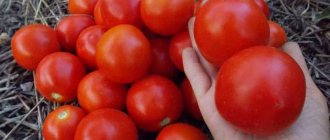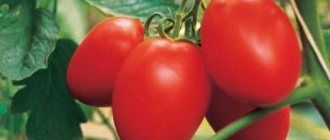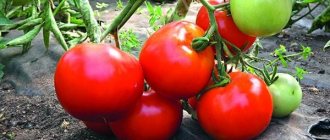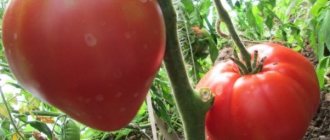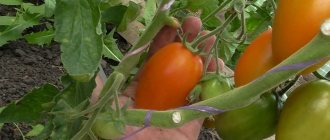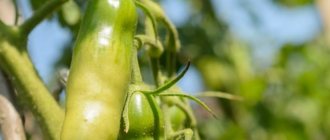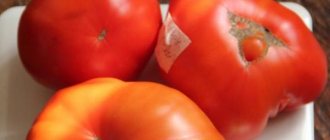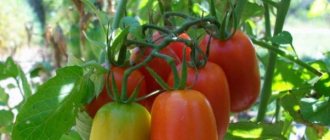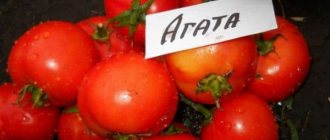Advantages of the variety
Among the advantages of Astrakhan, the main thing is its high productivity. Under production conditions, this variety yielded 70 t/ha and above. In open ground in the Volgograd and Astrakhan regions, as evidenced by reviews from gardeners, you can get a bucket of fruits from 1 m2.
The advantages of the variety include the fact that it does not have a green spot around the stalk. The variety is very resistant to fungal and viral diseases; blossom end rot does not affect it. This is one of those varieties that people say is “strong.”
Description and characteristics of the variety
An indeterminate standard plant, the height of which is between 65-80 cm. It is characterized by moderate foliage - the leaves are the most common, dark green in color. The inflorescence is intermediate.
Tomatoes have several varieties. Their seeds are considered somewhat of a scarcity, so if a gardener is lucky enough to find real seeds, it may be one of the following varieties:
- pink variety;
- red variety;
- orange variety.
Despite the difference in colors, not a single tomato is inferior in taste to its fellow.
Beneficial features
Astrakhan tomatoes are very rich in lycopene. This substance is necessary for the health of everyone, but especially men. The lycopene content is higher in tomatoes that have undergone heat treatment. The organic substance choline, found in large quantities in tomatoes, helps reduce cholesterol levels in the blood, protects the liver from fatty degeneration, increases overall immunity and stimulates the formation of hemoglobin in the blood.
See also
Description of the tomato variety Freken Bock, recommendations for growing and opinions of gardenersRead
Caring for Astrakhan tomato in open ground
Necessary care for Astrakhan tomatoes consists of observing watering standards, weeding, fertilizing, loosening the soil and applying fertilizer. If you follow the recommendations below, you will definitely replenish your reserves with a high level of harvest.
Watering a tomato
It is worth noting that tomatoes do not like either excess water or drought. That is, the next watering should begin as the soil dries. The best method of watering is drip. And here are some tips: water the tomatoes in the late afternoon, and at least once every two weeks add a couple of tablespoons of ash per 10 liters of water. This is the best method of prevention against a whole list of common diseases of cultivated plants.
Mineral supplementation
It is better to purchase a ready-made mineral mix. Firstly, it’s convenient, and secondly, you won’t have to worry about adding a lot or a little minerals. Feeding is carried out 3 times per season. Give preference to products that contain magnesium, boron and potassium.
Tying up bushes
After you have planted the tomatoes in a permanent location, the plant needs to be tied up. The fruits weigh a lot, so they can easily break tomato stems. Drive a peg 50-60 centimeters high, 10 cm from the plant, and tie the tomato with a rope. Don't forget about hilling, which needs to be done every 2-3 weeks. For a better harvest in early August, it is worth pinching the tops of all fruiting tomatoes. This will allow you to form the “correct” bush and increase the number of harvests!
Video about growing Astrakhan tomato:
Recommendations for cultivation
Astrakhan tomatoes are suitable for growing through seedlings or non-seedlings. In the first case, it should be sown for seedlings in early March. In a seedless culture, for example, in Astrakhan, sowing is done in April under film directly into open ground.
It is important that in a seedless crop, seed consumption is much higher than when sowing seedlings. You need to sow in a row in a row so that the seedlings lift the soil crust together, and then they are thinned out to the required distance of 35-45 cm. A tomato without seedlings is very strong, it requires less watering, since it has a deep root system, more fruits are formed on it. Try growing tomatoes like these!
During the initial growth period, tomatoes need to be fed with nitrogen-containing fertilizers. Foliar fertilizing with urea gives remarkable results. Before flowering, the tomato should be fed with a complete mineral fertilizer - with nitrogen, phosphorus and potassium. During the period of fruit growth, feeding with mullein is effective - the fruits will be large and sweet. Fresh mullein needs to be filled with water: 2 kg of mullein per bucket of water, leave this mixture in a closed container for 7 days for fermentation. Then dilute 5-6 times and water the plants at the root.
At the dacha, Astrakhan tomatoes definitely need support, since the plants are quite tall. If the crop is seedless and the distance between plants is small, then it is advisable to arrange low trellises, up to 1 m high, and string wires in 1-2 rows to support all the plants in the row.
If the bushes were planted not in a row, but in holes, then each bush can be supported individually. You need to tie the bush to the support approximately in its middle, ensuring reliable fastening.
Boarding order
The Astrakhan variety is used for planting in open areas or in greenhouse conditions. Seedlings are first obtained, which are then transferred to selected areas. Seedlings need good lighting and watering. The soil for planting tomatoes must be dug up and fertilized.
Growing seedlings
The soil for planting Astrakhan tomatoes begins to be prepared two weeks before work. It is obtained by combining equal proportions of turf and compost. It is recommended to prepare the soil in the fall or purchase a ready-made mixture for growing tomatoes.
If the soil is too heavy, add peat or coarse sand. A non-standard option for growing seedlings is to use coconut substrate. In it, tomatoes form a healthy root system, and the seedlings themselves develop quickly.
Advice! Before planting, it is recommended to calcine the soil in the oven or microwave for 10 minutes. The treated soil is left for 2 weeks, which is necessary for the development of beneficial bacteria.
A day before planting, it is necessary to prepare the seeds of the Astrakhan tomato variety, which are placed for a day in a saline solution (1 g of salt per 0.2 liter of water). After this treatment, shoots appear faster.
Containers with a depth of 10 cm are prepared for the seedlings. Soil is poured into them, in which furrows are made 1 cm deep. Seeds of the Astrakhan variety are placed in 2 cm increments, which need to be sprinkled with soil.
Until the first shoots, tomatoes are kept in a dark place at a constant temperature of 25-30 degrees. When sprouts appear, the containers are moved to a lighted place. For 12 hours, plants are provided with access to light. Periodically water the tomatoes with warm water.
Planting in a greenhouse
The soil in the greenhouse is prepared in the autumn. Up to 10 cm of the top layer of soil must be removed, since spores of fungal diseases and harmful insects overwinter in it. The remaining soil is dug up and fertilizers are applied per 1 m2: superphosphate (6 tbsp), potassium sulphide (1 tbsp) and wood ash (2 cups).
Important! Tomatoes that have reached a height of 20-25 cm and have 6-8 full leaves are transferred to the greenhouse. The age of such seedlings is 2 months.
The greenhouse for growing tomatoes is located in a well-lit area. It is covered with film, polycarbonate or glass. Be sure to provide vents for ventilation. Tomatoes are grown in one place every 3 years.
For the Astrakhan tomato variety, planting holes up to 20 cm deep are prepared to place the root system of the plants in them. Since the variety is low-growing, the tomatoes are arranged in a checkerboard pattern. This scheme makes it easier to care for tomatoes and allows you to control the density.
Leave 20 cm between plants, and up to 50 cm between rows. After planting, the tomatoes are watered abundantly. Over the next week, do not add moisture or fertilizing; it is enough to periodically loosen the soil and hill up the tomatoes.
Planting in open ground
According to reviews, Astrakhan tomato can be grown in open beds in the southern regions. You can use the seedling method or plant the seeds directly in open ground. If the second method is used, the growing process will take longer.
For tomatoes, beds are prepared where onions, beets, cabbage, carrots, herbs, and legumes previously grew. It is not recommended to plant tomatoes in one place for two years in a row, or to use areas after eggplants, potatoes, and peppers.
The soil in the beds is dug up in the fall, plant remains and other debris are removed. Be sure to add compost or rotted manure. In spring, it is enough to deep loosen the soil.
Advice! Holes for the Astrakhan variety are placed every 30 cm. 50 cm should be left between the rows.
Tomato seedlings are transferred to the depressions, leaving an earthen lump. Then the root system needs to be sprinkled with earth and the surface compacted a little. The final stage is to water the tomatoes abundantly.
This is interesting
In production conditions in the Astrakhan region, a special technology was developed, which had the name of the same name as the region. Using this technology, tomatoes were planted with very wide row spacing of 1.4 m and a very small distance between the bushes - 15-17 cm. With this scheme, the row is very dense, the bushes rarely fall apart, there is the possibility of machine harvesting and complete mechanization of all work.
See also
Description of the tomato variety Voskhod, its characteristics and cultivationRead
Main characteristics of the Astrakhan tomato
Astrakhan tomato is recommended for growing in open soil. It can be used not only fresh. The fruits are perfect for winter preservation, as well as for preparing tomato juice. Fruit ripening under normal temperature conditions occurs on the 120th day.
What is meant by the term “normal temperature conditions”? The optimal temperature for fruit ripening and growth is considered to be 20-24 degrees Celsius. The plant can reach a height of up to 80 centimeters.
The leaves are dark green, with a characteristic tart odor. The inflorescence is intermediate. Flowers are laid above the 8th leaf.
The fruits are quite large and dark red in color. The weight of one tomato can reach 100-120 grams. The number of nests is 6. The taste qualities of the Astrakhan tomato are at a high level, a slightly sweet taste predominates, and sourness is felt.
Features of Astrakhan tomato:
- Resistant to various diseases
- High yields
- It does not require special care
- The root system does not get buried in the soil, so the plant is easily pulled out when cleaning the garden plot
Reviews about the Astrakhan tomato are truly impressive. Most experienced gardeners value the plant for its high yield and taste. By the way, growing a cultivated vegetable is not so difficult. In general, planting, caring for and processing the plant is no different from other tomato varieties.
Watering a tomato
It is important not to overdo it with watering, since excess moisture greatly impairs the quality of the fruit . In dry, hot weather, the Astrakhan tomato variety needs to be watered 2 times a week. When daytime air temperatures are less than 30 °C, it is permissible to water the tomato once a week. When watering, you need to ensure that there is enough moisture to wet the soil layer at least half a meter.
To do this, you need to give at least 5 liters of water for each bush. If possible, install a drip irrigation system at your dacha. The experience of those who planted and grew these tomatoes in hot climates using drip irrigation suggests that they are very responsive to watering, in which soil moisture is always equally optimal without jumps up or down. The drip irrigation system is turned on once a week for 10-12 hours, the water supply rate is 1.5 - 2 l/h. The soil can be mulched or covered with a dark film.
The Astrakhan tomato will definitely delight you with delicious fruits and a large harvest!
Productivity
The fruit is round in shape. The weight of each tomato is 100-300 grams. The tomato is famous for its fleshy and tasty fruits, which, upon reaching maturity, acquire a bright red tomato color. There is no green spot on the stalk.
The average yield is 600 c/ha. The variety is characterized by abundant fruiting.
Recommended for fresh consumption, preparation of salads, appetizers, sauces. Slicing fresh Astrakhan tomatoes will decorate the dining table of every housewife.
Astrakhan Senior Tomato
| Name | Astrakhan Senior Tomato |
| Conversion date | 04.07.2013 |
| Size | 21.76 Kb. |
| Type | Presentations |
| Astrakhan Senior Tomato In the Astrakhan region - the peak of mass vegetable harvesting. Despite all the troubles that befell vegetable growers this season (unprecedented heat and locusts), the regional Ministry of Agriculture predicts that 20 percent more tomatoes will be harvested than in 2008. Moreover, exclusive varieties of tomatoes are supplied to the trading network - “Volgogradsky” and “Novichok”, which have become traditional for the lower reaches of the Volga, and the original “Seniors-tomatoes”. They once occupied a dominant place in the Astrakhan fields, but in the era of the struggle for the “Astrakhan million tons of vegetables,” the choice fell on more shelf-stable (mostly Dutch tasteless) varieties. Governor Alexander Zhilkin (by the way, himself an avid summer resident-experimenter) several years ago set the leaders of the regional agro-industrial complex, scientist-breeders and agricultural producers the task of remembering well-forgotten old varieties and working with new varieties of the All-Russian Research Institute of Irrigated Vegetable and Melon Growing (VNIIOB Kamyzyak city, Astrakhan region). |
What does a Kaspar F1 tomato look like?
Caspar F1 is a determinate hybrid of medium-early ripening tomatoes, equally suitable for cultivation in greenhouses, greenhouses and open ground. It was created in the Netherlands, but in most Russian regions this variety consistently produces a very good harvest, successfully adapting to the specifics of the local climate and the vagaries of the weather.
Hybrid tomato Caspar F1 is one of the many successful achievements of Dutch breeders
The property of determinacy means that the height of the bush is artificially limited. Upon reaching the limit values, a fruit cluster is formed at the top.
Infographics: a brief description of the Kaspar variety
Brief description of the Kaspar tomato variety
The manufacturer states that the height of Caspar F1 is a maximum of 50–55 cm, but in practice in open ground it stretches up to 80–90 cm, in a greenhouse or greenhouse - up to 1.1–1.3 m. The bushes are densely leafy, the leaves are large. However, the plants are quite compact.
The bushes of the Caspar F1 hybrid are not as miniature as the manufacturer claims, but they cannot be called very tall and oversized
The first fruits are harvested 85–90 days after planting the seedlings in a greenhouse and 100–110 days later in open ground. One bush brings up to 1.5 kg of tomatoes during the season; about 10 kg are harvested from 1 m². The harvest is tried at the end of June or early July, the bushes bear fruit until the last days of August, in warm southern regions - even until September.
Caspar F1 tomatoes are distinguished by the duration of fruiting, it stretches for two or more months depending on climatic and weather conditions
The skin of ripe tomatoes is a beautiful red-orange color, they are elongated-cylindrical in shape, reminiscent of bell peppers (there is even a typical sharp “spout”). The weight of the fruit is 80–120 g, rare specimens weigh up to 200 g. They have 3–4 chambers, no more, the tomatoes are very fleshy. The pulp is dense, the dry matter content in it is up to 5.2%. The taste is characteristic “tomato,” slightly sour.
Ripe Caspar F1 tomatoes are distinguished by their presentable appearance and very good taste.
The skin is extremely dense, even rough. If the fruits are used for salads, it is recommended to peel it. By the way, this is easy to do, without even scalding them with boiling water. But the density of the skin determines the excellent shelf life (at room temperature - up to a month, in optimal conditions - up to 8-10 weeks) and transportability of tomatoes, they do not crack on the bush, do not turn into an unappetizing mush during heat treatment, maintaining their shape, consistency of pulp and brightness of color even when cut into pieces.
Thanks to the latter property, Caspar F1 is highly valued by gardeners who use tomatoes mainly for homemade preparations. They praise the taste and appearance of salted, pickled and sun-dried tomatoes; they especially note the suitability of the hybrid for canning in its own juice.
Caspar F1 tomatoes are especially good in any homemade preparations
Video: how to cook tomatoes in your own juice for the winter
Kaspar F1 has good resistance to diseases typical of the crop. It does not suffer from verticillium and fusarium. The hybrid is less resistant to late blight, but it is saved by the ripening time - most of the harvest is harvested before the massive spread of the disease, which occurs in August, when the temperature drops and prolonged rains begin. Pests (with the exception of aphids) also do not show increased interest in this tomato.
Caspar F1 has genetically “built-in” immunity from Fusarium wilt - this dangerous disease can destroy a bush in a matter of days
Recently, the creators have improved the Kaspar F1 by creating “version 2.0” - the Hypil 108 F1 hybrid. It differs from the original in terms of ripening (10–15 days earlier) and the slight “barrel-shaped” shape of the fruit. Domestic breeders also worked with it, developing the hybrid Caspar 2, which was included in the State Register in 2015 and recognized as suitable for cultivation in all regions of Russia.
Since Kaspar F1 is a hybrid, there is no point in collecting seeds from personally grown fruits for planting next season. They will have to be purchased again every year. This is perhaps the only significant drawback of the tomato.
Tomato Caspar 2 differs from the “original” in a more saturated red skin color and slightly in the shape of the fruit
Advantages and disadvantages
- The main advantage of the Astrakhan tomato variety is its high yield. Thanks to the abundant fruiting, an average of 500-600 centners are harvested from one hectare, and experienced farmers under industrial conditions obtain yields of up to 70 tons per hectare. From one bed of an ordinary gardener, the yield is 7-9 kg per 1 sq.m.
- The peduncle is without the usual green spot around it;
- The variety is immune to the tobacco mosaic virus, and is also not affected by the Egyptian broomrape.
- The dense peel can be considered a disadvantage, but this is rather a plus, since the fruit does not crack and is easily transported and stored.
Loosen the soil after each watering
| Stage 1. Planting seedlings Step 1. Plant tomatoes in mid to late May. Pre-apply fertilizer to the area and dig it up. Step 2. Make holes according to the 60x70 cm pattern. After planting, compact the soil and water the tomatoes generously | |
| Stage 2. Watering Step 1. A day before starting work, pour water into containers so that it heats up and settles. Step 2 : Water in the evening after sunset. Use 5-6 liters of water per plant | |
| Stage 3. Loosening and weeding Step 1. Loosen the soil after each watering. This retains moisture in the soil and serves as a prevention for many diseases. Step 2: Weed twice a month | |
| Stage 4. Feeding Step 1. Buy a complex composition for tomatoes, this is the best option. Step 2. Apply fertilizer once every 3 weeks at the root | |
| Stage 5. Tying Option 1. The trellis is made in the form of a grid as in the photo, or in the form of a crossbar with tied ropes. Option 2. A peg is driven in near each plant, to which the stem is tied | |
| Stage 6. Timely harvesting Step 1. Harvest as they ripen to prevent ripe tomatoes from stealing nutrients from the plant. Step 2. Remove damaged and rotten fruits from the garden |
Resistance to diseases and adverse conditions
Unfortunately, the variety does not have high immunity to diseases, especially fungal ones. Most often, tomato suffers from late blight.
What are the signs of the disease?
- the underside of the leaf becomes stained;
- the shoots of the plant begin to darken, as does the stem itself;
- black spots appear on tomatoes;
- the leaves quickly dry out and fall off.
How to treat a bush?
If you notice only the initial signs of the disease, you can try treating the plant with fungicides. The most common are Fundazol, Hom, Ridomil.
Before flowering, as a preventive measure, the bush can be treated with a solution of copper sulfate. To prepare it, you need to dissolve 2 tablespoons of the substance in 10 liters of water.
If the damage is significant, then simply remove the bush from the garden bed, dig up the soil and treat the unaffected tomatoes. To be on the safe side, you can also treat the soil in the place where the infected bush grew.
What are the features of treatment?
It is forbidden to treat with both folk remedies and chemicals during the period of fruit formation.
If late blight develops frequently, alternate medications. Fungal disease is addictive and the drug that helped you previously may not work again.
For prevention, when digging or loosening the soil, add peat under each bush.
Do not plant Astrakhan orange tomato in places where onions, carrots, cucumbers or cauliflower previously grew.
Make sure that the bed is not too thick, remove the sailors as often as possible and follow the watering rules described above.
Do not forget about applying complex fertilizers, which contain a high fluorine content.
Is it really easy to grow a tomato?
When growing Astrakhan tomato, it is important to remember several things. Firstly, seeds can only be planted in open ground. And secondly, you should not plant several types of tomatoes in one bed. Cross pollination can affect the taste of ripe fruits.
You can plant seeds directly in open ground, or start growing seedlings. In the first case, it is better to start planting seeds in early or mid-April, when the soil is saturated with moisture and well warmed up. Using a garden tool, dig small holes, fill with enough water, and throw in 2-3 seeds.
The distance from hole to hole should be about 20-25 centimeters. The plant is not only tall, but also wide. Maintaining indentations will allow the root system to develop normally and absorb the optimal amount of water and minerals.
Features of growing seedlings:
- Pour black soil into the box. It can be fertilized with a mineral solution for vegetables, which is sold in the store.
- Place dry seeds in cheesecloth and soak them in a manganese solution for 24 hours (this will help kill bacteria).
- Using a small spatula, make small but long holes.
- Plant the prepared seeds and lightly sprinkle with soil.
- Cover the box with plastic wrap.
- Water the seedlings every 2-3 days.
The first true leaves will appear during the first two weeks. After the leaves appear, we recommend removing the plastic film and placing the box in a warm, well-lit place. Seedlings can be planted at the end or middle of May. After a month and a half, you will enjoy ripe and incredibly tasty tomatoes. But this is natural, subject to the basic rules of plant care.
Reviews from gardeners
Galina, Moscow
I was pleased that this variety does not stretch in seedlings; these were stocky, strong seedlings.
Source: tomatland.ru
Lyudmila, Smolensk
Tomatoes are one of the best: smooth, beautiful, tasty, and a very convenient size for canning.
Source: 1semena.ru
